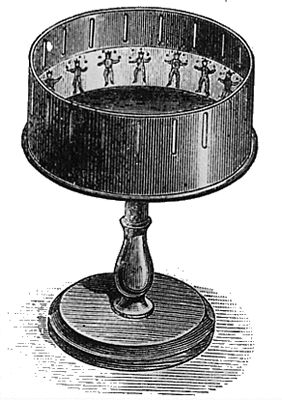I remember seeing one of these in a scary scene from the movie "The Woman in Black", but only thought of researching a little more about it this week.
The zoetrope is a device that produces the illusion of motion from a rapid succession of static pictures. Its name means "the weel of life". It consists of a cylinder with slits cut vertically in the sides. On the inner surface of the cylinder is a band with images from a set of sequenced pictures. As the cylinder spins, the user looks through the slits at the pictures across. The scanning of the slits keeps the pictures from simply blurring together, and the user sees a rapid succession of images, producing the illusion of motion.
The earliest known zoetrope was created in China around 180 AD by the inventor Ting Huan, and was driven by convection. The modern one, however, was only invented in 1833 by British mathematician William George Horner, who called it the "daedalum" (most likely as a reference to the Greek myth of Daedalus), though it was popularly referred to as "the wheel of the devil". It failed to become popular until the 1860s, when it was patented by both English and American makers, including Milton Bradley. The American developer William F. Lincoln named his toy the "zoetrope". Almost simultaneously, similar inventions were made independently in Belgium by Joseph Antoine Ferdinand Plateau (the phenakistoscope) and in Austria by Simon von Stampfer (the stroboscope).
Nowadays, some marketing companies invest in 3D zoetropes, which often use several tiny figures to create the illusion of movement, through a spinning mechanism and the use of the concept of “persistence of vision", like the ancient devices.
The zoetrope is a device that produces the illusion of motion from a rapid succession of static pictures. Its name means "the weel of life". It consists of a cylinder with slits cut vertically in the sides. On the inner surface of the cylinder is a band with images from a set of sequenced pictures. As the cylinder spins, the user looks through the slits at the pictures across. The scanning of the slits keeps the pictures from simply blurring together, and the user sees a rapid succession of images, producing the illusion of motion.
The earliest known zoetrope was created in China around 180 AD by the inventor Ting Huan, and was driven by convection. The modern one, however, was only invented in 1833 by British mathematician William George Horner, who called it the "daedalum" (most likely as a reference to the Greek myth of Daedalus), though it was popularly referred to as "the wheel of the devil". It failed to become popular until the 1860s, when it was patented by both English and American makers, including Milton Bradley. The American developer William F. Lincoln named his toy the "zoetrope". Almost simultaneously, similar inventions were made independently in Belgium by Joseph Antoine Ferdinand Plateau (the phenakistoscope) and in Austria by Simon von Stampfer (the stroboscope).
Nowadays, some marketing companies invest in 3D zoetropes, which often use several tiny figures to create the illusion of movement, through a spinning mechanism and the use of the concept of “persistence of vision", like the ancient devices.
~Ally

 RSS Feed
RSS Feed